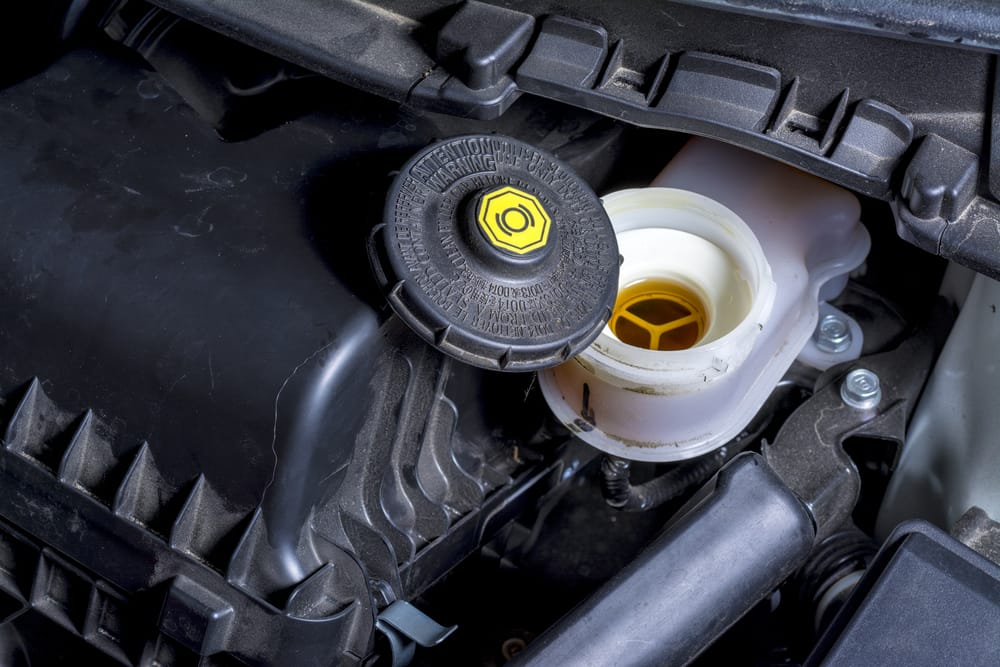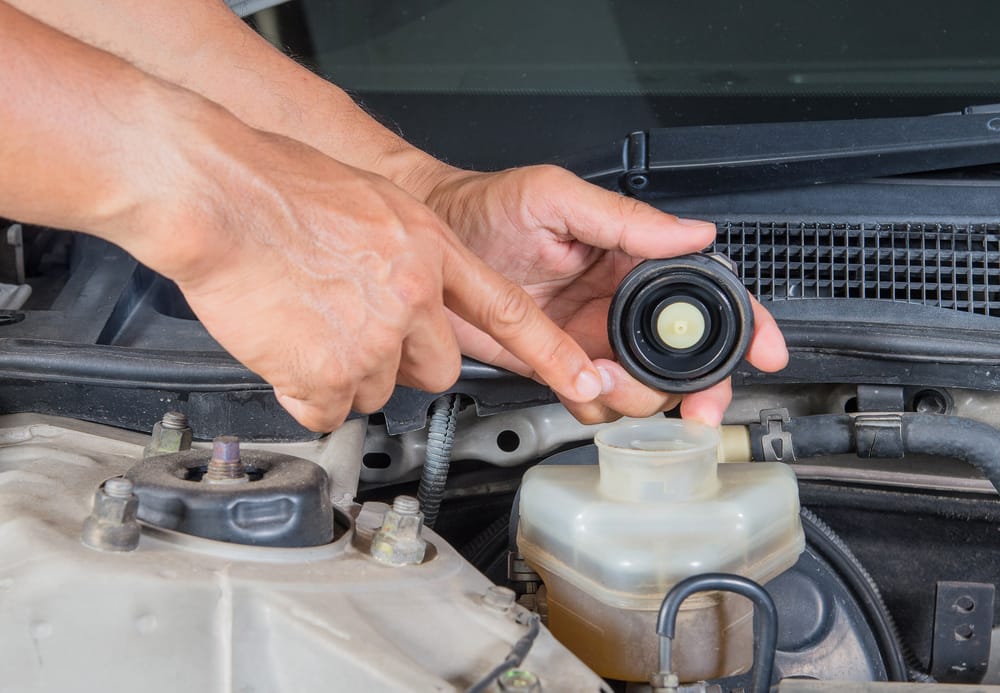
When brake fluid becomes old, it loses its moisture resistance. As it
absorbs moisture, tiny air bubbles form, making the brakes less effective
and responsive. Bleeding the car brakes is a way to restore their optimum
performance.
You bleed the brakes with the master reservoir cap on but unscrewed.
Keeping the cap unscrewed allows the old brake fluid to come out
smoothly, while leaving it atop the reservoir prevents the caustic
fluid from squirting.
 Removing the brake fluid cap before bleeding the brakes.
Removing the brake fluid cap before bleeding the brakes.
Do You Have To Remove The Brake Fluid Cap When Changing Brake Pads
Removing the brake fluid cap when changing brake pads makes it easier
to push the pistons back to make more room for the new brake pads.
Since new brake pads are thicker than your old, worn ones, they push the
piston back toward the brake line for proper installation.
When the piston moves back, it pushes the brake fluid in the lines toward
the reservoir.
This won't be a problem if the brake fluid level in the main reservoir is
already low.
But if it is full, removing the cap gives brake fluid more space, so it
does not overflow.
What Happens If You Bleed Brakes With Cap On?
If you bleed the brakes with the cap on, the brake fluid won't flow out
as smoothly as it does when the cap is unscrewed.
You can bleed brakes with the cap fitted on the master reservoir. The cap
is vented so the air can displace the brake fluid as it goes down the
lines.
Opening the bleeder screw with the master reservoir cap on will make the
system bleed. The fluid, however, won'twon't come out as quickly and
smoothly as it does when the cap is slightly unscrewed.
 Removing the brake fluid cap and inspecting the fluid.
Removing the brake fluid cap and inspecting the fluid.
How Do You Know You Have To Bleed The Brakes?
Some signs you may need to bleed the brakes are:
-
Delayed braking:
Your brakes take longer to slow down or stop the vehicle.
-
Spongy brake pedal:
Your brake pedal doesn'tdoesn't feel as tight and firm as before.
-
Uneven braking: Your vehicle does not slow or stop every time you
press the brakes.
-
Reduced braking power: Your brakes are not working as efficiently
as before.
-
Leaks:
You have found a leak that is letting air in.
-
As a precaution:
When you change the vehicle's rotors or pads.
-
As a part of car maintenance:
Bleeding the brakes once a year is good preventive maintenance.
Do You Bleed The Brakes With The Car Off?
Yes, you should bleed the brakes with the car off. This is because when
you press the pedal in a running car, the brake fluid will come out
with high pressure, which is unnecessary for bleeding the brakes.
When your car is running, and you press the brake pedal, it can produce
around 100 psi of pressure which is enough to stop a car traveling at a
fast speed.
This amount of pressure, however, is unnecessary for bleeding the brakes
because you are pushing the fluid out of an open pipe without any
resistance. So, the task is better done with the car off.
What Is The Proper Way To Bleed Brakes?
Bleeding the car brakes means removing the air bubbles in the braking
system. If you plan to do this manually, you'll need the assistance of a
helper. Here is the proper way to bleed car brakes:
-
Purchase the type of brake fluid as recommended in the owner's manual.
-
Lift the car and remove its wheels
-
Gently loosen all bleeder screws taking care not to break or strip
them.
-
Use the owner's manual to find the master cylinder and make sure the
master cylinder is full.
-
Take a long piece of ¼ inch clear tubing and fit one end over the
bleeder screw of the wheel furthest away from the driver's side.
-
Put the other end into your catch container.
-
Ask your helper to press the brake pedal a few times and shout
"Pressure" when they feel firm resistance.
-
As they maintain pressure, you open the bleeder screw and collect the
brake fluid in the catch container.
-
Your helper should shout "floor" just before the pedal touches the
floor. Close the bleeder screw at this point.
-
If running low, top up the brake fluid reservoir with more fluid and
continue bleeding the same brake for at least five times more.
-
Add more fluid to the reservoir when necessary.
-
Use the same method to bleed all the brakes in the sequence given in
your owner's manual.
-
When done, ask your helper to press the brake pedal and note the
disturbance in the brake fluid reservoir. A sudden fluid eruption means
some air is still in the system, while a modest disturbance means you
have properly bled your car brakes.
-
Make sure all the bleeder screws are properly closed, reinstall the
wheels and lower your car.
Is A Brake Reservoir Cap Vented?
A brake reservoir cap is vented to let air in as the brake fluid level
drops. However, you should still loosen it while bleeding the brakes to ensure air flow.
Most vehicles today have composite plastic brake fluid reservoirs with
screw-on caps.
The caps are vented to let air in, displacing the brake fluid as it goes
down the brake lines.
But because of the brake fluid's hygroscopic nature, there is also a
rubber gasket between the cap and the reservoir that flexes inwards,
preventing air from contaminating the fluid.
Conclusion
Bleeding the brakes is an essential part of car maintenance.
You should bleed the brakes with a slightly unscrewed cap. It ensures that
your brake fluid comes out smoothly, but none squirts out of the reservoir.
Bleeding brakes is a two-person job, so make sure to enlist the help of an
assistant before starting the task.
You should keep your car off while bleeding brakes; otherwise, the fluid
may come out with excessive force.